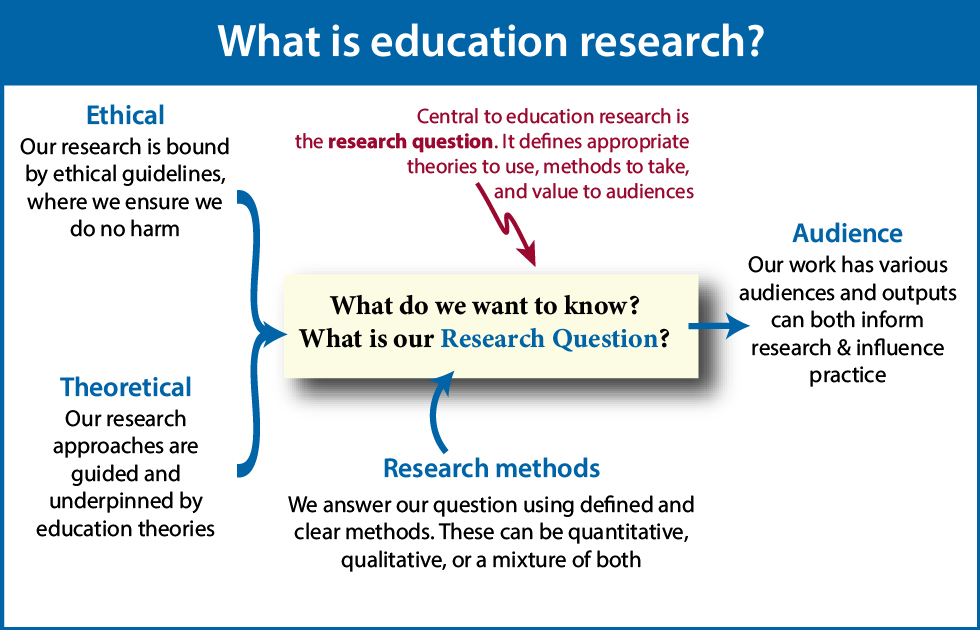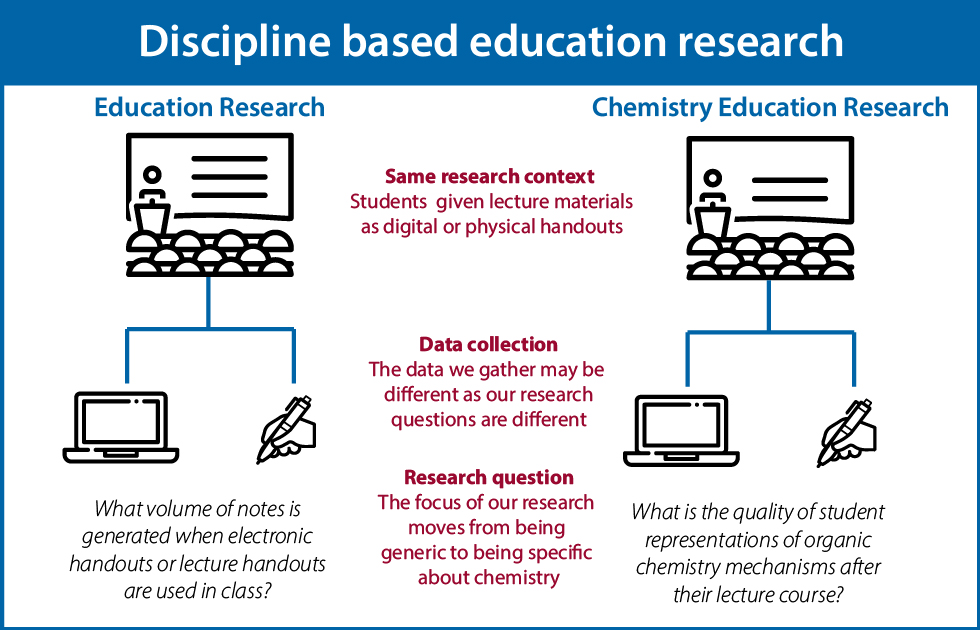 An overview of education research
An overview of education research
Education research is an academic discipline which focusses on exploring all aspects of education. This includes finding out about what students know, how students learn, and investigating teaching approaches. Its focus can range from one student’s learning to a national education system, to a teaching approach across many different contexts. The assumed rationale for completing education research is to find out more, and hence improve teaching and learning at all levels of education.
Based in theory
Education research has some particular characteristics. As an academic discipline, it builds on educational theory. This means that an education publication will always refer to some theory upon which the publication is based. As well as giving the publication a scholarly rigour, this theoretical base gives the research a framework through which the results are viewed. An author who believes learning happens best through social interaction in a classroom will complete a very different type of analysis to one who believes it is best to learn by rote. These different frameworks are called theoretical frameworks, and we will talk later about how you select a particular framework, or perhaps, how it selects you! For now, it is enough to say that building educational research on a particular theory means that the work is an academic pursuit, rather than, say, journalism, which will report findings without necessarily making the link to an underlying theory.
Led by research questions
A second characteristic of education research is that the purpose of a particular research approach is typically made explicit by writing a research question. This identifies what specific insights the researcher intends their research to provide. Data is analysed in the context of the research question with the intention of answering the question. The idea of asking research questions explicitly and intentionally will seem unusual for those coming from a chemistry background, but in laboratory-based chemistry research, there are assumed research questions. A study of reaction mechanisms in solvents with different polarities might aim to explore whether polarity affects a particular mechanism. It is less common to state such a question explicitly in chemistry research. It is commonly used in education research as it aims to make clear what exactly is being investigated in what is often a very complex setting. We will look at the approach to writing (and re-writing!) research questions later, but for now it is enough to say that in adopting a research question, we are stating in advance of the research study what it is we wish to find out. Just as in a typical scientific research approach, we might make a particular investigation based on a hypothesis, itself informed by our knowledge of the theory of the discipline. After completing the research and addressing the question, we can consider how it fits with the hypothesis, and either confirm the hypothesis or investigate further.
Has defined methods
A third characteristic of education research is that it has its own set of instruments or methods used to find out answers to questions we are interested in. These methods relate to those used in other similar fields such as psychology, anthropology, and philosophy. The instruments used in any particular study need very careful consideration and great attention is paid to research methods in education research. An especial consideration is whether the method is useful for measuring what it is we want to know (as defined by the research question). In chemistry, we learn about research methods and their applicability. We know that absorption spectroscopy will report information on the electronic structure of molecules, but it isn’t (usually) much use for vibrational information. If you were asked to find out vibrational frequencies of a compound, you would more likely choose the method of infrared spectroscopy. Similarly, in education research, different methods are useful for finding out different things, but with the additional complication that it is typically involving human beings, rather than molecules. This makes things more challenging! We will explore useful methods for education research later in this guide.
Implications for practice
We mentioned above that there is an assumed aim of education research to find out about learning and teaching, with a view to improving teaching and learning. Therefore, a final characteristic of educational research we will mention here is that educational research has implications for the practice of teaching. This places the academic discipline of education research in an unusual position. A chemistry researcher will investigate some aspect of their chemistry, and report their findings to their peers in scholarly journals with the aim of improving the knowledge base of that particular discipline. A researcher in inorganic chemistry, for example, might explore a particular synthetic approach and determine that by using a different pH, a better yield is performed. She could report this, so that others can benefit from this knowledge. There is a sharing of knowledge among researchers within the field. Education research is different. Education researchers explore teaching and learning and report their findings. While part of this dissemination aims to improve understanding among those in the discipline – sharing details of research findings – another part aims to inform those teaching students about their findings – sharing implications of research findings. Teachers at all levels of chemistry are professionals in teaching students in a classroom, and may be unfamiliar with research approaches and the language of education research. Care needs to be taken in ensuring findings that are useful for practice of teaching are reported to those who are capable of making use of the implications of these findings. We will discuss reporting of education research below.
The field of chemistry education research
So far we have considered some general features of educational research, and it is an obvious extension to say that chemistry education research is the field of education research looking in particular at teaching and learning in chemistry. Chemistry education research is one of a subset of discipline-based education research fields (DBER), which are areas of education research focussing on particular (usually scientific) sub-disciplines. Other DBER research areas include physics education research, geosciences education research, research in undergraduate mathematics education, and so on. Each of these research areas aim to further understand teaching and learning within their own discipline.
So what makes something education research and something chemistry education research? And why does it matter?
Comparing education research and chemistry education research
Let’s we explore what is meant by chemistry education research by looking at two related studies. Suppose we were to explore whether students write more notes in class if they are given lecture handouts, compared to whether the notes were in electronic format for viewing on laptops. In this study we might compare the volume of notes taken and report whether there was a difference between this volume, drawing appropriate conclusions. In this study, we are interested in something other than chemistry – we are looking at the volume of notes produced. The situation in a chemistry lecture is incidental; the researchers are unlikely to find out anything about specifically teaching and learning of chemistry in this case. From the perspective of a chemistry education researcher, this type of research has been described as collateral to chemistry education research; it happens to be in a chemistry lecture but the outcomes of the research are of interest to and have implications for a broader audience, and so sits better in the broader field of education research.
Suppose we reframe the study. We are still interested in exploring lecture handouts, but now we want to know about how well students can draw an organic reaction mechanism as a result of being taught in the two different scenarios, all other things being equal. In this case, we will have a similar set up, but the data being gathered is now related to the new focus, specific to chemistry. The researchers need to know about chemistry, about this mechanism, about how different drawings impart information on different levels of chemical knowledge. This research is very much in the field of chemistry education research, and the study is likely to give us some knowledge about how a general teaching and learning approach affects something relevant to chemistry – the drawing of organic reactions. It may also be of interest to other disciplines where drawing is important, but the researchers’ clear focus here was on chemistry education. This type of research has been described as embedded in chemistry education research; a general teaching and learning consideration with specific and purposeful focus on what it means for chemistry.
Welcome to CER
Why does all of this matter? The different focus in each of these hypothetical studies underpins a very important point about the field of chemistry education research. The chemistry education researcher needs to know about education research and its approaches, about chemistry and how it can be interpreted, and about how to gather useful information about teaching and learning in chemistry using education research approaches. The discipline of chemistry education research is a hybrid of two very different academic disciplines – chemistry and education – and those who work in this discipline need to bring their understanding of both of these academic disciplines to their study. In response to this, the field of chemistry education research (CER) has emerged with a specific focus on drawing together education research approaches as applied to chemistry. There are research groups and scholarly journals devoted to the field of chemistry education research, reflecting the specialisms within this particular discipline. Having a background in chemistry means that beginning in the academic discipline of chemistry education can seem a bit daunting, with the vast scholarship of education to take on board. But approaching this discipline as a chemist means you bring a specialism and experience that is very powerful, and means you have a background expertise that can help make a meaningful contribution to this academic discipline.
The intention of this guide is to show you how to begin. Welcome aboard!
Further Reading
- National Research Council. 2012. Discipline-Based Education Research: Understanding and Improving Learning in Undergraduate Science and Engineering. Washington, DC: The National Academies Press. https://doi.org/10.17226/13362.
- Seery, M. K., Kahveci, A., Lawrie, G. A. and Lewis, S. E. (2019) ‘Evaluating articles submitted for publication in Chemistry Education Research and Practice’, Chemistry Education Research and Practice, 20, pp. 335-339. https://doi.org/10.1039/C9RP90003A
- Taber, K. S. (2013) ‘Three levels of chemistry educational research’, Chemistry Education Research and Practice, 14(2), pp. 151-155. https://doi.org/10.1039/C3RP90003G
To cite this page (Harvard)
Seery, M. K. (2021) What is chemistry education research?. Available at: http://www.michaelseery.com/1-what-is-chemistry-education-research (Accessed: 31st February 2021).
